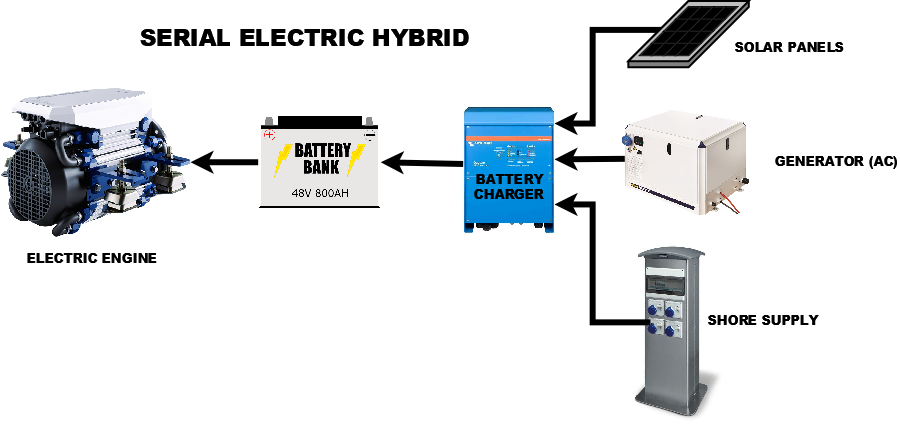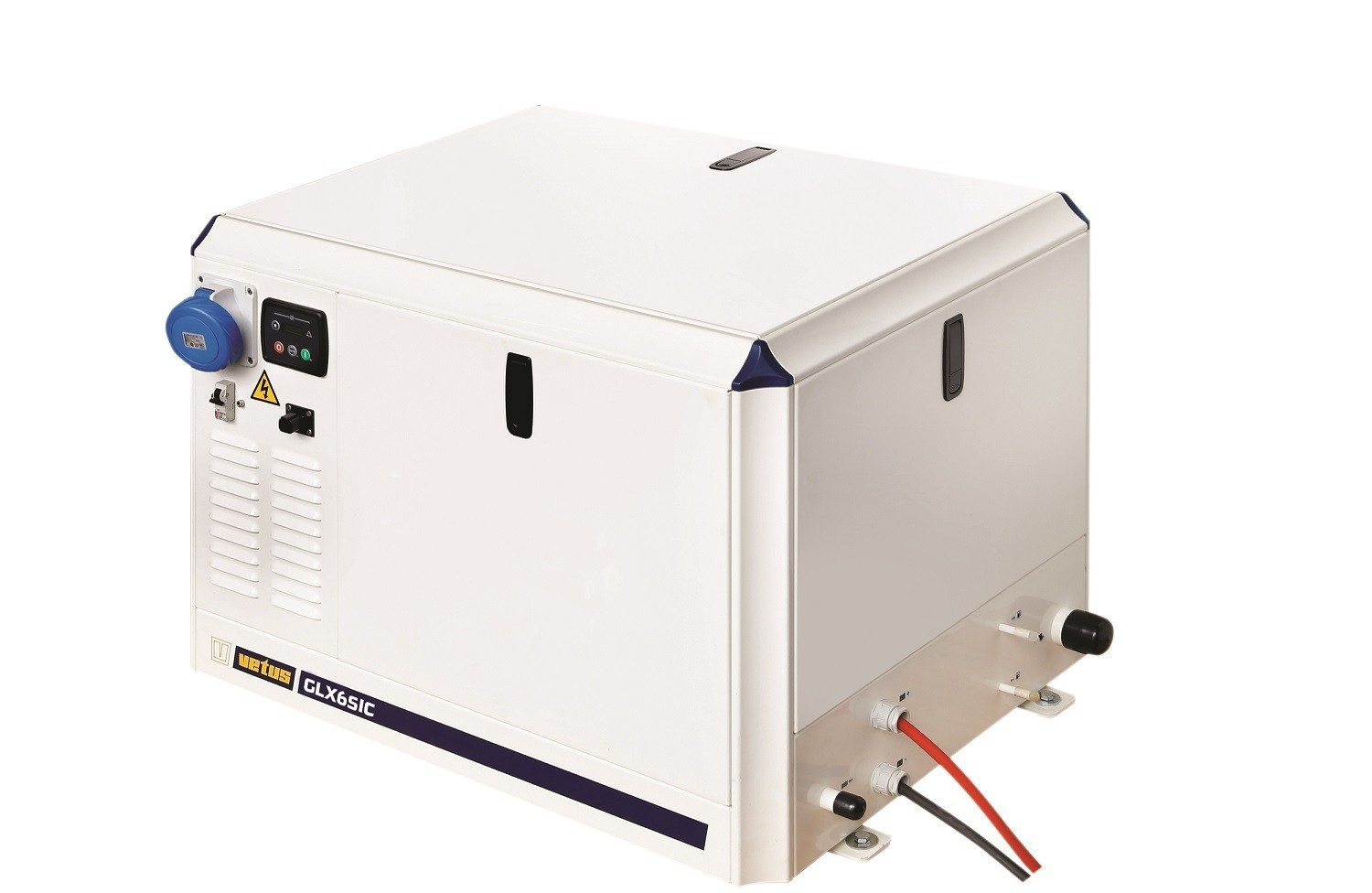When people talk about hybrid engines, it is usually the nice, clean, environmentally friendly part that gets all of the attention. I have already posted about our brand new and exciting Vetus E-Line 10KW electric engine, so I thought a post about the less glamorous but equally important diesel generator was in order.
Let’s remind ourselves of what “Old Nick’s” serial hybrid system consists of .

As you can see, there are three sources of power to keep the batteries topped up and allow the electric engine to do it’s thing, but only one of them is guaranteed to always be available (assuming you remembered to fill up the diesel tank). The diesel generator, is unfortunately, a “necessary evil” on a continuous cruising narrowboat. If we only wanted to go out for day trips or weekends, returning to a marina to re-charge or we were cruising in the Canal du Midi with plentiful all year sunshine, then maybe we could be 100% environmentally friendly. However, living aboard, in the UK and with the current affordable technology, a generator is mandatory.
Before starting this project, if someone mentioned a narrowboat generator, I would immediately have pictured a small Honda (other makes are available) generator buzzing away on the tow path, spoiling the tranquility. So it was quite enlightening when I discovered the world of large inboard diesel generators.
A diesel generator is basically a diesel engine squeezed in to a sound-proofed box. It has all of the characteristics and features of a normal diesel engine – i.e. it consumes diesel, is noisy, creates exhaust gasses, gets hot, needs servicing, etc. – but it is deployed only when power is required and its sole function is to efficiently convert kinetic energy into electrical energy.
Choosing an inboard diesel is a compromise between electrical power output (large as possible) and the maximum physical size that will fit in the available space. Other key features to consider are:
- DC or AC output
- Engine Noise in dBs
- Operating engine speed (RPM)
- Wet or dry exhaust
- Cost
- Interfacing
- Servicing
If our budget had been unlimited, then we probably would have gone for a 10KVA, AC output, super quiet, low revving, dry exhaust generator with an NMEA 2000 interface and remote on/off. Unfortunately, our budget was restricted and so we had to start pruning our wish list.
By reducing the power output, having a wet exhaust and not worrying about interfacing, a number of models came within our budget. One of these was the Vetus GLX6.5SIC and once we became aware of the new Vetus E-Line engine, allowing us to get the complete serial hybrid from one manufacturer, the choice was made.
The GLX6.5SIC has a Vetus M3.29 diesel which is a super-quiet, compact and reliable 3 cylinder (Mitsubishi based) engine. This is combined with a brushless AC generator with automatic voltage regulator (AVR), which produces 6KVA of pure sine wave 230v AC output. The generator will feed our Victron Quattro battery charger and ensure the 48v 800Ah battery bank is charged in the most efficient manner.
By utilising the remote on/off switch of the GLX6.5SIC, Ortomarine’s innovative colour touch screen controller will be able to switch on the generator when the batteries start to get below 50% SOC and switch the generator off when the batteries reach around 90% SOC, letting the solar take care of the last 10%. It is surprising how long (several hours) it takes to complete this last 10% of the charge cycle, and running the generator for this amount of time is really inefficient.
The GLX6.5SIC operates at 1500 RPM, about half the speed of many inboard generators, which helps it keep to a very low 57db noise level (about the level of an air-con unit). Add this to a special 40mm Gas Separator Exhaust, that Vetus make, which separates the water and exhaust gases (water expelled below water line and gas above) and you have a very quiet, wet exhaust system, without the “splash-splash” sound that you often hear with inboard generators.
I hope to do all of my own servicing on “Old Nick” and so I was particularly interested in the ease of servicing of the GLX6.5SIC which has all of the serviceable parts on the front side of the engine and all of the pipes and cables exiting on the right side engine. Also the sound proof casing has a series of panels that can easily be unclipped and slid out, so I am confident that it will be a fairly easy process.
Here is a short video showing the GLX6.5SIC and although I expect most people will not get too excited about a diesel engine in a box, I am really looking forward to seeing it in action.


Dear Paul,
Very much enjoy your blog. I learn a lot from it. Thank you for publishing it. If I’ve understood correctly, your motor and generator are both water-cooled. Do both sides of the swim (together) provide enough “coolth” or have you had to come up with a different approach, please? Best wishes – Andrew Campbell.
Hi Andrew, glad you like the blog. We are using a skin tank as you guessed to cool the electric engine which actually does not need that much cooling. The Vetus generator will use raw water cooling, with a wet exhaust. The generator will also be plumbed in so that it heats the calorifier. We did consider a dry exhaust but as we will always be on the boat and have some control over when we run the generator, we felt it was an unnecessary expense. Cheers Paul
Dear Paul, Thank you. Very interesting. In my ignorance, I’d assumed that mud boxes and filters were invariably a no-no these days. But you’ve obviously given this a lot of thought. Thank you for answering. You must be nearing launch day. I hope it all goes swimmingly for you. Best wishes – Andrew.
Paul
Where are you placing the generator? At the front or in the ‘engine’ compartment? I’m just curious as to how you manage to fit all the pipe work to prevent water ingress either via the exhaust or the water intake. From other wet systems I’ve looked at it seems you need quite a bit of height above waterline to prevent that.
Thanks